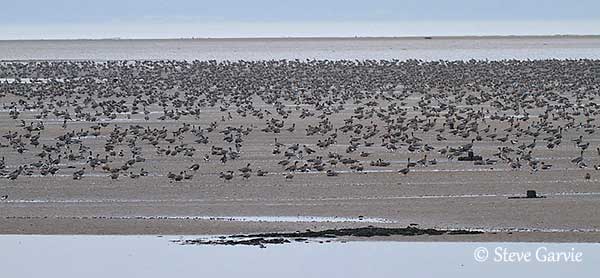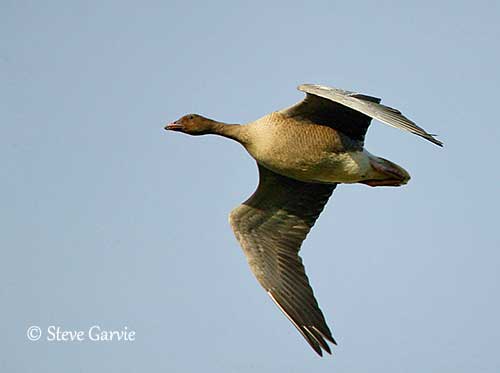
Fr: Oie à bec court
Ang: Pink-footed Goose
All: Kurzschnabelgans
Esp: Ánsar piquicorto
Ita: Oca zamperosee
Nd: Kleine Rietgans
Sd: Spetsbergsgås
Norv: Kortnebbgås
Photographers:
John Anderson
John Anderson Photo Galleries
Steve Garvie
RAINBIRDER Photo galleries & Flickr Rainbirder
Otto Plantema
Trips around the world
Nicole Bouglouan
PHOTOGRAPHIC RAMBLE
Text by Nicole Bouglouan
Sources:
HANDBOOK OF THE BIRDS OF THE WORLD vol 1 by Josep del Hoyo-Andrew Elliot-Jordi Sargatal - Lynx Edicions - ISBN: 8487334105
THE HANDBOOK OF BIRD IDENTIFICATION FOR EUROPE AND THE WESTERN PALEARCTIC by Mark Beaman, Steve Madge - C. Helm - ISBN: 0713639601
THE COMPLETE BOOK OF BRITISH BIRDS – Written by “Royal Society for the Protection of Birds” experts - Préface de Magnus Magnusson - Michael Cady- Rob Hume Editors - ISBN: 0749509112
ENCYCLOPEDIE DES OISEAUX DE FRANCE ET D’EUROPE – de Peter Hayman et Rob Hume - Flammarion – ISBN : 2082009920
GUIDE DES CANARDS, DES OIES ET DES CYGNES – de Steve Madge - Delachaux et Niestlé - ISBN: 2603013769
Birds of Britain - The Web Magazine for Birdwatchers
What Bird-The ultimate Bird Guide (Mitchell Waite)
Wikipedia, the free encyclopaedia
Pink-footed Goose
Anser brachyrhynchus
Anseriformes Order – Anatidae Family
INTRODUCTION:
The Pink-footed Goose is included in the subfamily Anserinae, tribe Anserini, in the family Anatidae. The large tribe Anserini includes the swans and the “true” geese of both genera Anser and Branta.
This gregarious species breeds in Greenland, Iceland and Svalbard, and winters in NW Europe. It frequents tundra lakes and wet meadows, but usually breeds well above the sea-level in rocky areas and on islands.
The Pink-footed Goose has currently an increasing population, despite illegal hunting and disturbance by farmers, due to the negative impact of these geese on agriculture. The breeding success is affected by these disturbances, and the bird is also threatened by future habitat loss. The adults abandon the nest if they are disturbed by humans, making the eggs an easy target for Arctic foxes and Glaucous Gulls.
The Pink-footed Goose is currently not globally threatened, thanks to the considerable increase of the population over recent decades.

DESCRIPTION OF THE BIRD:
Biometrics:
Length: 60-75 cm
Wingspan: 135-170 cm
Weight: M: 1900-3900 g – F: 1450-2800 g
The Pink-footed Goose adult has dark brown head and upper neck, and pale grey-brown body. Rump, belly and vent are white. The tail is grey with broad white terminal band. On the upperwing, the flight-feathers are blackish-grey, whereas wing-coverts are pale bluish-grey.
Lower neck and breast are paler brown. Flanks are dark brown, with blackish-brown vertical streaks. There is a white line on the upper flank, joining the white rump and belly.

The bill is pink with black tip and base. The eyes are dark brown. Legs and webbed feet are pink.
Male and female have similar plumage, but the male is larger than female.

The juvenile resembles adult but it is smaller, duller and browner. The upperparts show heavier scaly pattern. Bill and legs are duller, with legs sometimes ochre-coloured. It is almost similar to adult by the end of the first winter.
RANGE:
The Pink-footed Goose breeds in E Greenland, Iceland and Svalbard. This species winters in Britain, Denmark, The Netherlands and Belgium. This is the commonest goose in Svalbard. Populations from Greenland and Iceland winter in British Isles.

HABITAT:
The Pink-footed Goose breeds in large fjords (Spitsbergen) and on rocky outcrops, mountainous areas with deep ravines and gorges in very open tundra, and also on islands and islets. This species breeds up to 700 metres above sea-level.
The Pink-footed Goose winters in lowland farmland and by wide estuaries. On passage, it feeds in fertilized grasslands and cereal fields. Formerly, it was mainly on coastal tundra and at saltmarshes, or in naturally vegetated areas in uplands.

CALLS AND SONGS: SOUNDS BY XENO-CANTO
The Pink-footed Goose is highly vocal and has higher-pitched calls than those of other geese. It gives a high-pitched, sharp “wink-wink” and utters a musical, deep, double or treble honking “ahng-ahng-ahng”. They produce an incessant cackling when in flight.

BEHAVIOUR IN THE WILD:
The Pink-footed Goose is herbivore and feeds on both green parts and roots of plants. But its diet includes several types of plant material such as leaves, stems, berries, seed heads of sedges, mosses and lichens during the nesting period. During winter, it feeds on grain, potatoes, vegetables and grasses.
It feeds on high-energy food (berries of Empetrum) during the moult of the flight-feathers before the migration.

The Pink-footed Goose forages on dry land, mainly farmland, but also in water. They can form large feeding flocks of up to 5000 birds in Britain. They often return to the same feeding areas year after year.

The Pink-footed Goose may form sometimes loose colonies, but the pairs have a territory. The colonies may include up to 10 pairs, with nests placed 5 to 75 metres apart depending on the location. They also breed as isolated pairs. The geese remain usually paired for life. Unlike ducks, both adults share the nesting duties. They migrate in family groups.

Pair formation and courtship displays are usually performed on the wintering areas or during the migration towards the breeding grounds, because the duration of good weather conditions and food abundance is too short for a whole breeding cycle. The pairs are ready to reproduce as soon as they arrive at their breeding sites. They are probably monogamous. They perform ritualized courtship displays that affect only the two birds involved.

The Pink-footed Goose is migratory. The breeding birds of Iceland and Greenland winter in Scotland and England, whereas the birds that breed in Svalbard spend the winter in Belgium and The Netherlands, through Norway and Denmark.
They usually leave the breeding grounds as soon as late August/mid-September, and they return in April until mid-May. They migrate in large flocks and according to weather conditions, they may reach speeds of 40-60 km/hour. The families remain together until the return to the breeding grounds.
The Pink-footed Goose has swift, direct flight with powerful wingbeats.



REPRODUCTION OF THIS SPECIES:
The laying starts between 7 and 15 May in Iceland, and late May/early June in E Greenland and Svalbard.
The Pink-footed Goose may breed in small, loose colonies of about 10 pairs, or as isolated pairs too. It nests on cliffs or on lake islets, in order to avoid predation. The nest is usually a scrape in the ground, lined with soft plants and more extensively with down.


The female lays 3-6 pale greenish or straw-coloured eggs at one-day intervals. She incubates alone during 25-28 days, while the male guards her at some distance. At hatching, the chicks have pale brownish down above and yellowish below, with dark crown. They are precocial and reared by both parents. They fledge between 50 and 60 days after hatching. They can breed at 3 years old.
During this period, the adults moult to replace the flight-feathers prior to the migration. This species produces only one brood per season.

PROTECTION / THREATS / STATUS:
The Pink-footed Goose is affected by illegal hunting in spring in Iceland, and suffers from disturbance and persecution by farmers because the species is a problem on agricultural grasslands.
General disturbance from helicopters in oil exploitation areas, land management changes and future habitat loss in Iceland due to development of hydroelectric projects involving flooding of major moulting areas, are the main threats that affect this species. The Arctic fox affects the nesting success in Svalbard.
The global population has not been quantified, but the overall trend is suspected to be increasing (2006).
The Pink-footed Goose is currently evaluated as Least Concern.
